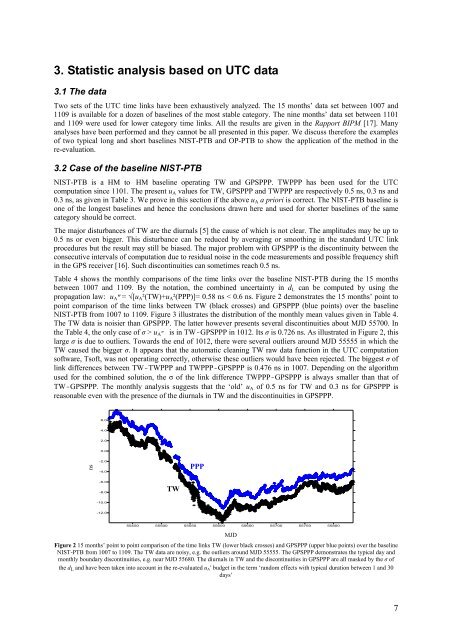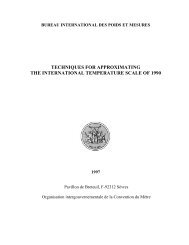On the measurement quality of UTC time transfer - BIPM
On the measurement quality of UTC time transfer - BIPM
On the measurement quality of UTC time transfer - BIPM
You also want an ePaper? Increase the reach of your titles
YUMPU automatically turns print PDFs into web optimized ePapers that Google loves.
3. Statistic analysis based on <strong>UTC</strong> data<br />
3.1 The data<br />
Two sets <strong>of</strong> <strong>the</strong> <strong>UTC</strong> <strong>time</strong> links have been exhaustively analyzed. The 15 months’ data set between 1007 and<br />
1109 is available for a dozen <strong>of</strong> baselines <strong>of</strong> <strong>the</strong> most stable category. The nine months’ data set between 1101<br />
and 1109 were used for lower category <strong>time</strong> links. All <strong>the</strong> results are given in <strong>the</strong> Rapport <strong>BIPM</strong> [17]. Many<br />
analyses have been performed and <strong>the</strong>y cannot be all presented in this paper. We discuss <strong>the</strong>refore <strong>the</strong> examples<br />
<strong>of</strong> two typical long and short baselines NIST-PTB and OP-PTB to show <strong>the</strong> application <strong>of</strong> <strong>the</strong> method in <strong>the</strong><br />
re-evaluation.<br />
3.2 Case <strong>of</strong> <strong>the</strong> baseline NIST-PTB<br />
NIST-PTB is a HM to HM baseline operating TW and GPSPPP. TWPPP has been used for <strong>the</strong> <strong>UTC</strong><br />
computation since 1101. The present uA values for TW, GPSPPP and TWPPP are respectively 0.5 ns, 0.3 ns and<br />
0.3 ns, as given in Table 3. We prove in this section if <strong>the</strong> above uA a priori is correct. The NIST-PTB baseline is<br />
one <strong>of</strong> <strong>the</strong> longest baselines and hence <strong>the</strong> conclusions drawn here and used for shorter baselines <strong>of</strong> <strong>the</strong> same<br />
category should be correct.<br />
The major disturbances <strong>of</strong> TW are <strong>the</strong> diurnals [5] <strong>the</strong> cause <strong>of</strong> which is not clear. The amplitudes may be up to<br />
0.5 ns or even bigger. This disturbance can be reduced by averaging or smoothing in <strong>the</strong> standard <strong>UTC</strong> link<br />
procedures but <strong>the</strong> result may still be biased. The major problem with GPSPPP is <strong>the</strong> discontinuity between <strong>the</strong><br />
consecutive intervals <strong>of</strong> computation due to residual noise in <strong>the</strong> code <strong>measurement</strong>s and possible frequency shift<br />
in <strong>the</strong> GPS receiver [16]. Such discontinuities can some<strong>time</strong>s reach 0.5 ns.<br />
Table 4 shows <strong>the</strong> monthly comparisons <strong>of</strong> <strong>the</strong> <strong>time</strong> links over <strong>the</strong> baseline NIST-PTB during <strong>the</strong> 15 months<br />
between 1007 and 1109. By <strong>the</strong> notation, <strong>the</strong> combined uncertainty in dL can be computed by using <strong>the</strong><br />
propagation law: uA”= √[uA²(TW)+uA²(PPP)]= 0.58 ns < 0.6 ns. Figure 2 demonstrates <strong>the</strong> 15 months’ point to<br />
point comparison <strong>of</strong> <strong>the</strong> <strong>time</strong> links between TW (black crosses) and GPSPPP (blue points) over <strong>the</strong> baseline<br />
NIST-PTB from 1007 to 1109. Figure 3 illustrates <strong>the</strong> distribution <strong>of</strong> <strong>the</strong> monthly mean values given in Table 4.<br />
The TW data is noisier than GPSPPP. The latter however presents several discontinuities about MJD 55700. In<br />
<strong>the</strong> Table 4, <strong>the</strong> only case <strong>of</strong> σ > uA” is in TW-GPSPPP in 1012. Its σ is 0.726 ns. As illustrated in Figure 2, this<br />
large σ is due to outliers. Towards <strong>the</strong> end <strong>of</strong> 1012, <strong>the</strong>re were several outliers around MJD 55555 in which <strong>the</strong><br />
TW caused <strong>the</strong> bigger σ. It appears that <strong>the</strong> automatic cleaning TW raw data function in <strong>the</strong> <strong>UTC</strong> computation<br />
s<strong>of</strong>tware, Ts<strong>of</strong>t, was not operating correctly, o<strong>the</strong>rwise <strong>the</strong>se outliers would have been rejected. The biggest σ <strong>of</strong><br />
link differences between TW-TWPPP and TWPPP-GPSPPP is 0.476 ns in 1007. Depending on <strong>the</strong> algorithm<br />
used for <strong>the</strong> combined solution, <strong>the</strong> σ <strong>of</strong> <strong>the</strong> link difference TWPPP-GPSPPP is always smaller than that <strong>of</strong><br />
TW-GPSPPP. The monthly analysis suggests that <strong>the</strong> ‘old’ uA <strong>of</strong> 0.5 ns for TW and 0.3 ns for GPSPPP is<br />
reasonable even with <strong>the</strong> presence <strong>of</strong> <strong>the</strong> diurnals in TW and <strong>the</strong> discontinuities in GPSPPP.<br />
ns<br />
6.0<br />
4.0<br />
2.0<br />
0.0<br />
-2.0<br />
-4.0<br />
-6.0<br />
-8.0<br />
-10.0<br />
-12.0<br />
TW<br />
PPP<br />
55450 55500 55550 55600 55650 55700 55750 55800<br />
MJD<br />
Figure 2 15 months’ point to point comparison <strong>of</strong> <strong>the</strong> <strong>time</strong> links TW (lower black crosses) and GPSPPP (upper blue points) over <strong>the</strong> baseline<br />
NIST-PTB from 1007 to 1109. The TW data are noisy, e.g. <strong>the</strong> outliers around MJD 55555. The GPSPPP demonstrates <strong>the</strong> typical day and<br />
monthly boundary discontinuities, e.g. near MJD 55680. The diurnals in TW and <strong>the</strong> discontinuities in GPSPPP are all masked by <strong>the</strong> σ <strong>of</strong><br />
<strong>the</strong> dL and have been taken into account in <strong>the</strong> re-evaluated uA’ budget in <strong>the</strong> term ‘random effects with typical duration between 1 and 30<br />
days’<br />
7
















